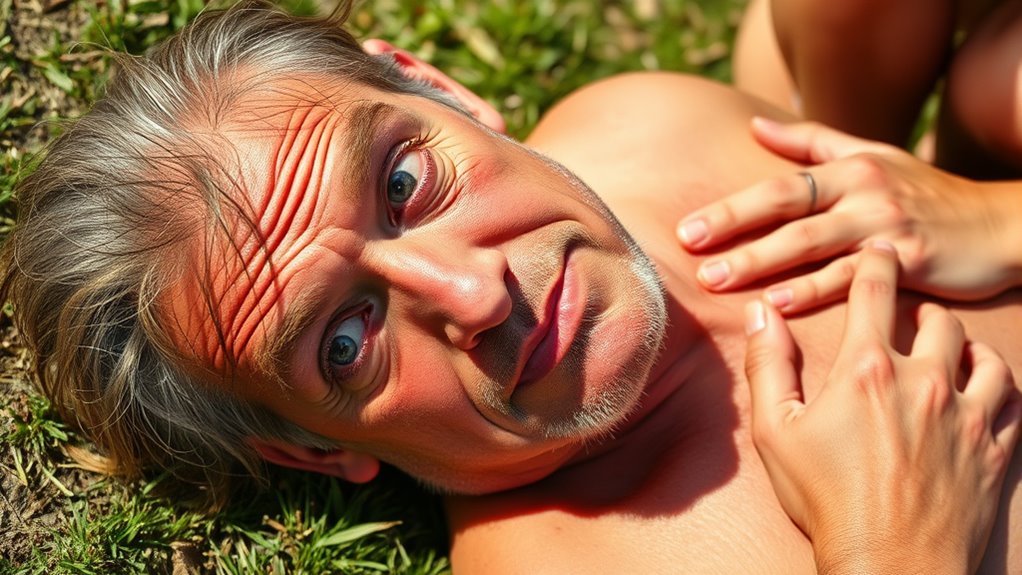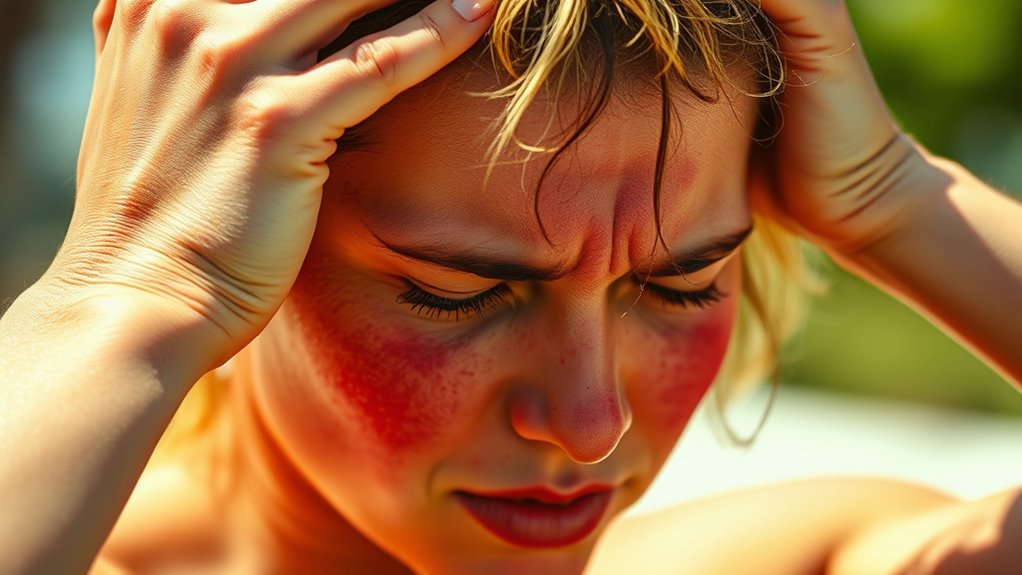To recognize heatstroke and heat exhaustion symptoms, look for heavy sweating, weakness, dizziness, nausea, headache, and muscle cramps for heat exhaustion. Your skin may feel cool, moist, or, in severe cases, hot and dry for heatstroke, which can cause confusion, rapid heartbeat, or fainting. Act quickly by moving to a cooler place and hydrating, but if symptoms worsen or you see someone unconscious, seek emergency help immediately. More details can help you stay alert.
Key Takeaways
- Heat exhaustion symptoms include heavy sweating, weakness, dizziness, nausea, headache, muscle cramps, and cool, moist skin.
- Heatstroke signs include body temperature above 103°F, confusion, rapid heartbeat, dry skin, and possible loss of consciousness.
- Fainting, rapid heartbeat, and muscle cramps are common indicators of heat exhaustion needing prompt rest and hydration.
- Sudden mental confusion, hot/dry skin, and rapid breathing signal potential heatstroke requiring immediate emergency care.
- Recognizing early symptoms allows for quick intervention, preventing severe health consequences or death.

During hot weather, it’s essential to recognize the symptoms of heat-related illnesses like heat exhaustion and heatstroke before they become life-threatening. Knowing how to spot the warning signs can save your life or someone else’s. One of the most effective ways to prevent serious problems is by maintaining proper hydration. Hydration strategies involve drinking plenty of fluids—preferably water—and avoiding alcohol or caffeine, which can dehydrate you further. If you’re outdoors, carry a water bottle and sip regularly, even if you don’t feel thirsty. Remember, thirst is a late indicator of dehydration, so proactive drinking is crucial. Alongside hydration, practicing sun safety tips helps reduce your risk. Wear lightweight, light-colored, loose-fitting clothing, and a wide-brimmed hat to shield your head and neck from direct sunlight. Apply broad-spectrum sunscreen generously to all exposed skin, and seek shade whenever possible, especially during peak hours from 10 a.m. to 4 p.m.
As the heat intensifies, pay close attention to your body’s signals. Symptoms of heat exhaustion include heavy sweating, weakness, dizziness, nausea, headache, and muscle cramps. You might notice your skin feels cool and moist, but you could also experience fainting or a rapid heartbeat. If you observe these signs, it’s essential to act immediately. Move to a cooler place, rest, and hydrate with fluids containing electrolytes if possible. Loosen tight clothing and cool your skin using a damp cloth or by fanning yourself. If symptoms worsen or don’t improve within 30 minutes, seek medical attention promptly, as heat exhaustion can quickly escalate to heatstroke. Additionally, indoor air quality can influence your overall comfort and health during heat waves, especially if your home’s ventilation is inadequate.
Heatstroke is far more perilous and requires urgent medical intervention. Its symptoms include a high body temperature—usually above 103°F—confusion, rapid heartbeat, rapid breathing, nausea, and even loss of consciousness. Your skin may be hot and dry if sweating has stopped, which indicates your body can no longer regulate temperature effectively. If you or someone else shows signs of heatstroke, call emergency services immediately. While waiting for help, try to cool the person down with cold packs, immerse them in cold water if possible, or spray them with cool water. It’s critical not to delay treatment because heatstroke can cause permanent damage or death.
Understanding these symptoms and implementing simple prevention measures like hydration strategies and sun safety tips can make all the difference. Staying vigilant, especially during extreme heat, helps protect you from the dangerous consequences of heat-related illnesses.
Frequently Asked Questions
How Can I Prevent Heat-Related Illnesses During Outdoor Activities?
To prevent heat-related illnesses during outdoor activities, you should stay well-hydrated by following effective hydration strategies like drinking water regularly. Wear lightweight, loose-fitting, and light-colored clothing to help keep your body cool. Take frequent breaks in shaded areas, avoid strenuous activity during peak heat, and listen to your body’s signals. These steps help your body manage heat better and reduce the risk of heat illnesses.
What Are the Long-Term Health Effects of Heatstroke?
Heatstroke can leave lasting scars, like a wildfire burning through your body’s defenses. You might face heatstroke complications such as long-term neurological effects, including memory loss or difficulty concentrating. These effects can linger like shadows, affecting your daily life long after the heatwave has passed. Protect yourself by staying cool and hydrated, because safeguarding your health today prevents the silent, lasting damage heatstroke can cause tomorrow.
Can Children or Elderly People Experience Different Symptoms?
Yes, children and elderly people often experience different symptoms. Kids may display pediatric symptoms like irritability, dizziness, or nausea, while older adults might show geriatric signs such as confusion, weakness, or fainting. You should watch for these unique signs, as they can indicate heat-related illnesses. Promptly seek medical help if you notice any of these symptoms, since early treatment can prevent serious complications.
Are There Specific Medications That Increase Heat Illness Risk?
You should be aware that certain medications, due to their medication effects, can subtly increase your risk of heat illness. Drugs like diuretics, antihistamines, and certain antidepressants may interfere with your body’s ability to regulate temperature, especially when combined with drug interactions. If you’re on these medications, you might feel more vulnerable during hot weather. Always consult your healthcare provider about how your medications could impact your heat tolerance.
When Should I Seek Emergency Medical Help for Heat-Related Symptoms?
You should seek emergency response immediately if you notice signs of heat stroke, like confusion, rapid heartbeat, or loss of consciousness. Don’t wait—call 911 right away. Heat stroke is life-threatening and requires urgent medical attention. If symptoms are milder but worsening, get to a healthcare facility promptly. Prompt emergency response can prevent serious complications and save your life. Always prioritize quick action when heat-related symptoms become severe.
Conclusion
Now that you know the signs, you’ll spot heatstroke and heat exhaustion before they worsen—like catching a quick glimpse of a familiar face in a crowded place. Sometimes, these symptoms show up when you least expect it, just like a sudden summer breeze. Staying alert and responding promptly can make all the difference, turning what might seem like a coincidence into a lifesaving moment. Trust your instincts and keep yourself safe in the heat.










